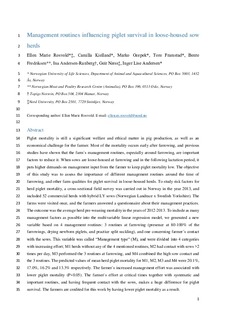Management routines influencing piglet survival in loose-housed sow herds
Rosvold, Ellen Marie; Kielland, Camilla; Ocepek, Marko; Framstad, Tore; Fredriksen, Bente; Andersen-Ranberg, Ina; Næss, Geir; Andersen, Inger Lise
Journal article, Peer reviewed
Accepted version
Permanent lenke
http://hdl.handle.net/11250/2499295Utgivelsesdato
2017Metadata
Vis full innførselSamlinger
Originalversjon
Rosvold, E. M., Kielland, C., Ocepek, M., Framstad, T., Fredriksen, B., Andersen-Ranberg, I., . . . Andersen, I. L. (2016). Management routines influencing piglet survival in loose-housed sow herds. Livestock Science, 196, 1-6. doi: 10.1016/j.livsci.2016.12.001Sammendrag
Piglet mortality is still a significant welfare and ethical matter in pig production, as well as an economical challenge for the farmer. Most of the mortality occurs early after farrowing, and previous studies have shown that the farm's management routines, especially around farrowing, are important factors to reduce it. When sows are loose-housed at farrowing and in the following lactation period, it puts higher demands on management input from the farmer to keep piglet mortality low. The objective of this study was to assess the importance of different management routines around the time of farrowing, and other farm qualities for piglet survival in loose-housed herds. To study risk factors for herd piglet mortality, a cross-sectional field survey was carried out in Norway in the year 2013, and included 52 commercial herds with hybrid LY sows (Norwegian Landrace x Swedish Yorkshire). The farms were visited once, and the farmers answered a questionnaire about their management practices. The outcome was the average herd pre-weaning mortality in the years of 2012–2013. To include as many management factors as possible into the multivariable linear regression model, we generated a new variable based on 4 management routines: 3 routines at farrowing (presence at 80–100% of the farrowings, drying newborn piglets, and practice split suckling), and one concerning farmer´s contact with the sows. This variable was called “Management type” (M), and were divided into 4 categories with increasing effort; M1 herds without any of the 4 mentioned routines, M2 had contact with sows >2 times per day, M3 performed the 3 routines at farrowing, and M4 combined the high sow contact and the 3 routines. The predicted values of mean herd piglet mortality for M1, M2, M3 and M4 were 20.1%, 17.0%, 16.2% and 13.3% respectively. The farmer's increased management effort was associated with lower piglet mortality (P<0.05). The farmer's effort at critical times together with systematic and important routines, and having frequent contact with the sows, makes a huge difference for piglet survival. The farmers are credited for this work by having lower piglet mortality as a result.
Beskrivelse
Author's accepted version (post-print).

